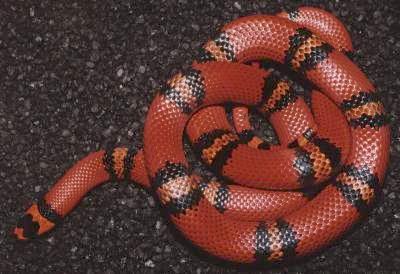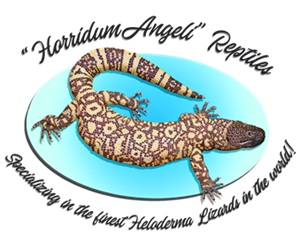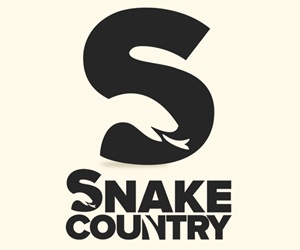
- Scarlet Kingsnake
- Lampropeltis triangulum hondurensis
- Size:
- Hatchling: 8 - 10 in.
- Adult: 38 -48 in.(normal) 27 in.(record)
- Scalation:
- Dorsal: 21 - 23 rows
- Ventral: 216 - 221
- Sub caudal: 49 - 61
- Infra labial: 8 - 10
- Supra labial: 7 - 8
- Anal Plate: Single
|

Photo courtesy High Mountain Reptiles
click to enlarge |
Written by John Cherry
Coloration
A number of color morphs, such as typical tri-colored animals, tangerines, anerythristics, albino's and all variations in between, are being captive bred in fair numbers. This is one of the most beautiful and variable Lampropeltis triangulum subspecies found in collections, in
this authors opinion. Two color forms are found in the wild. The normal tri-color phase and the orange tangerine phase.
Head:
Normally displays a broad snout band of yellow or white and a second band at the base of the head of the same color with the balance of the head being black.
Dorsal:
This is a banded animal. In the normal tri-colored phase, the bands are black red/orange and either yellow or white. In the tangerine phase the bands are black, red/orange, and orange. The black bands normally don't touch on the spine. Both phases have black tipping on their scales, covering anywhere from 5% to 40% of each scale.
Ventral:
Bands of black, red/orange and yellow in the normal tri-colored phase that extend across the
entire belly area. In the tangerine phase, bands of black, red/orange and orange extend across the ventral scales.
Range:
Portions of rainforest in Honduras, Nicaragua and portions of North East Costa Rica.
Habitat:
This is a species of low to medium elevations of the tropical areas of the country's listed above. It has been suggested that specimens from higher elevations are less melanistic
Prey:
In captivity these animals fair very well on a diet of lab. raised mice. Juveniles are large robust neonates. They are generally aggressive feeders that are easy to start. In the wild they feed on small lizards, small snakes, nestling birds with the bulk of the diet being rodents.
Behavior:
This is a very large species that does well in captivity. In wild caught individuals they can be
prone to biting and are somewhat nervous. Captive born animals start out as slightly more flighty as hatchlings, but with handling and age they tend to get away from this behavior. They become favorites in most collections, because of the wide variety of colors and morphs, plus their ease of care.
Breeding:
Breeding in captivity is achieved in the same manner as with most colubrids using the following as a guideline. Towards the middle of October cease feeding totally, allowing at least 2 -3 weeks at normal temperature for clearing of the gut. Then gradually reduce the ambient tempeture inside the cage to the middle 50's/low 60's and maintain for a period of 3 months. Be sure and provide clean water and systematically check animals for general condition and welfare during this period. middle of the brumation cycle with good success. After brumation and the animals are brought back up to optimum temperature of 76 - 82 degrees, feeding should resume for approx. three weeks and the pair should be placed together under supervision for short periods of time until copulation can be confirmed. An egg laying chamber/box partially filled with damp vermiculite or sphagnum moss is helpful. Eggs should be removed immediately after laying and placed in damp vermiculite for the incubation period of 58 - 66 days at temperatures of 80 - 83 degrees.
Literature Cited:
Stebbins,Robert C. 1985 second editition revised. A field guide to Western
Reptiles and Amphibians. Houghton Mifflin Company
Cherry, John & Cindy Field & Breeding Notes

Photo by
Click to Enlarge |

Photo by
Click to Enlarge |
|
|
Sponsored Link
New & Updated Business Listings
Looking for a reptile or amphibian related business? A reptile store, breeder, importer,
maunfacturer or supplier? Our business directory lists some of the most popluar herp businesses in the world.
| Locate a reptile or amphibian business by name:
|
|
Recent Milk Snake Forum Forum Posts
• I'm here, too!, posted by Sunherp
• Kingsnake lives!, posted by exposito
• Hey Everybody, I'm here., posted by AaronBayer
• Scott Ballard Provided A Wealth Of Info, posted by Ameron
• Central America Milksnake Dilemma, posted by Ameron
• Retun to Forum / New Stuart's Milksnake , posted by Ameron
• Eggs ok?, posted by highley1980
• Splotched Sinaloan Variety, posted by bslugger551
• Splotched/Bullseye Sinaloans, posted by bslugger551
• Is my milk snake is getting TOO HOT?, posted by darbellah
• New owner looking for advice, posted by Irishfran
• New adoption biting and chewing fingers, posted by ajcur17
• Help*** Our milksnake won’t eat., posted by KieranSnake
• "trouble" with my milk snake, posted by kedjkd
• L. annulata (Mexican Milk) temps, posted by JJJ
Recent Milk Snake Classifieds:
- WANTED Milksnakesall spe...
- 4 foot Sinaloan Milksnak...
- 10 Adult Pueblan milk
Banner Pool
|











